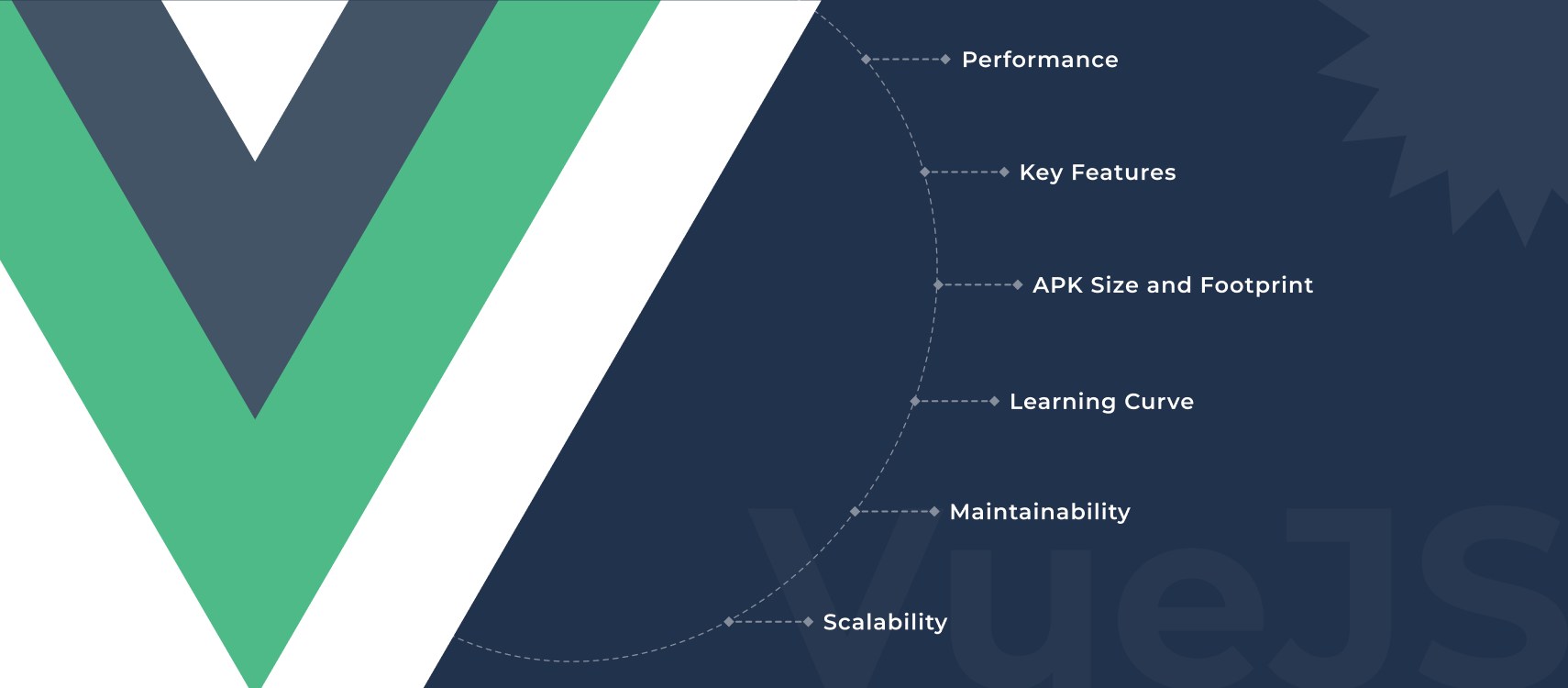Table of Contents
- Performance
- Key Features
- APK Size and Footprint
- Learning Curve
- Maintainability
- Scalability
- Compare with Other Frameworks
- React
- Angular
- Summarising
In today’s digital age, web applications are becoming increasingly complex, demanding more sophisticated front-end frameworks to deliver seamless user experiences. Vue.js has emerged as a popular JavaScript framework due to its unique blend of simplicity, performance, and flexibility. Businesses can benefit from Vue.js development services in more ways than one.
In this article, we will explore the key advantages of Vue.js for modern web applications, covering aspects such as performance, key features, APK size and footprint, learning curve, maintainability, and scalability. At the end of the article you can figure out why hiring Vue.js developers from a reliable Vue.js development company can make a difference to your web app project.
Performance
Performance is a critical aspect of any web application, as it directly impacts user engagement and satisfaction. Vue.js offers several performance advantages that make it stand out among other front-end frameworks.
Virtual DOM:
Vue.js uses a virtual DOM, which is a lightweight copy of the actual DOM, to efficiently update and render changes. This minimizes unnecessary reflows and repaints, resulting in faster rendering and better performance.
Reactive Data Binding:
Vue.js employs a reactive data binding system that automatically updates the DOM when the underlying data changes. This approach ensures efficient updates and helps in reducing rendering time.
Lazy Loading:
Vue.js supports lazy loading of components, allowing web applications to load only the necessary components when needed, reducing the initial load time.
Code Splitting:
Vue.js supports code splitting, enabling developers to break down their code into smaller chunks, and load only the required modules, further improving performance.
Key Features
Vue.js offers a rich set of features that empower developers to build robust and feature-rich web applications.
Vue.js Light Mode:
Vue.js 3 introduces a light mode that significantly reduces the library size for production builds, contributing to smaller APK sizes.
Tree Shaking:
Vue.js leverages tree shaking, a technique that eliminates unused code during the build process, further reducing the APK size.
Custom Build Configuration:
Vue CLI allows developers to customize the build configuration and remove unnecessary features, minimizing the final APK size.
APK Size and Footprint
Mobile applications face challenges related to APK size and footprint, affecting user experience and app installation rates. Vue.js provides several optimizations to address these concerns.
Vue.js Light Mode:
Vue.js follows a component-based architecture, allowing developers to create reusable and modular components, promoting code reusability and maintainability.
Vue CLI (Command Line Interface):
Vue.js provides Vue CLI, a powerful command-line tool that automates the project setup and scaffolding, making development more efficient.
Directives:
Vue.js provides directives like v-if, v-for, and v-bind, simplifying DOM manipulation and enhancing code readability.
Vuex:
Vuex is Vue.js’s official state management library, enabling developers to manage application-wide states and data in a centralized store.
Routing:
Vue Router offers seamless routing capabilities, enabling developers to create single-page applications (SPAs) with ease.
Learning Curve
The learning curve of a framework is an essential consideration for businesses and developers. Vue.js strikes a balance between simplicity and power, making it easy to pick up.
Progressive Learning:
Vue.js is designed with progressive adoption in mind. Developers can start with simple concepts and gradually explore more advanced features as needed.
Clear Documentation:
Vue.js boasts well-structured and comprehensive documentation, aiding developers in understanding the framework and its ecosystem effectively.
Large Community:
A vibrant community around Vue.js offers extensive resources, tutorials, and support for learners, reducing the learning curve.
Maintainability
Maintaining and updating web applications over time is a crucial aspect for businesses to ensure their longevity. Vue.js promotes maintainability through various features.
Component Reusability:
Vue.js’ component-based architecture encourages code reusability, enabling developers to maintain and update code more efficiently.
Readability:
Vue.js’ clear and concise syntax enhances code readability, making it easier for developers to understand and maintain the codebase.
Devtools:
Vue.js provides robust developer tools that aid in debugging and inspecting the application’s state, contributing to better maintainability.
Scalability
As web applications grow, their scalability becomes essential to handle increased user loads and accommodate future expansion. Vue.js supports scalability in the following ways.
Ease of Learning:
Vue.js’ component-based architecture allows developers to create modular components, making it easier to scale and extend the application.
Performance Optimizations:
Vue.js’ performance-oriented features, like lazy loading and code splitting, enable the application to scale gracefully without compromising performance.
Server-Side Rendering (SSR):
Vue.js supports SSR, enabling server-side rendering of components, which can improve performance and SEO for large-scale applications.
Let’s Compare With Other Leading Frameworks
Vue.js has gained popularity in the world of front-end development, but how does it stack up against other leading frameworks like React and Angular? Let’s delve into a comparison of Vue.js with these two prominent competitors.
React
Ease of Learning:
Both Vue.js and React have relatively gentle learning curves, making it easy for developers to get started. However, Vue.js’s template syntax might be more intuitive for beginners compared to React’s JSX approach.
Performance:
Vue.js and React are neck-to-neck in terms of performance. Vue.js’s virtual DOM and React’s virtual DOM are both efficient ways of updating the DOM, resulting in similar rendering speeds.
Size and Footprint:
Vue.js tends to have a smaller footprint compared to React. Vue.js 3’s light mode and tree shaking optimizations contribute to smaller bundle sizes.
State Management:
Vue.js provides Vuex as the official state management solution, while React relies on third-party libraries like Redux. The choice between them depends on the complexity and scale of the application.
Community and Ecosystem:
React has a larger community and ecosystem compared to Vue.js, offering more third-party libraries, tools, and resources. However, Vue.js’s community is rapidly growing and vibrant.
Component Reusability:
Both Vue.js and React follow a component-based architecture, allowing developers to create reusable components for enhanced code maintainability.
Angular
Learning Curve:
Angular has a steeper learning curve compared to Vue.js. Its extensive documentation and complex architecture might be challenging for beginners.
Performance:
Vue.js generally outperforms Angular due to its lightweight and efficient virtual DOM implementation. However, the performance gap might vary based on the specific use case and optimization strategies.
Size and Footprint:
Vue.js has a smaller bundle size compared to Angular, resulting in quicker initial load times and better mobile performance.
Flexibility:
Vue.js is more flexible and allows developers to integrate it into existing projects easily. In contrast, Angular has a stricter approach to its architecture and can be more challenging to integrate into projects built with other frameworks or libraries.
Two-Way Data Binding:
Angular uses two-way data binding by default, which can make the data flow more predictable for some developers. Vue.js, on the other hand, uses one-way data binding by default, which can be simpler for managing state changes.
Tooling:
Angular comes with a comprehensive CLI toolset, offering more out-of-the-box features for project scaffolding and code generation. Vue CLI provides a similar experience but may require additional configuration for specific needs.
Summarising
Vue.js has earned its reputation as a powerful and developer-friendly JavaScript framework, offering a myriad of advantages for modern web applications. Leveraging Vue.js development services can further ensure the success of web application projects, delivering top-notch user experiences in today’s competitive digital landscape.










